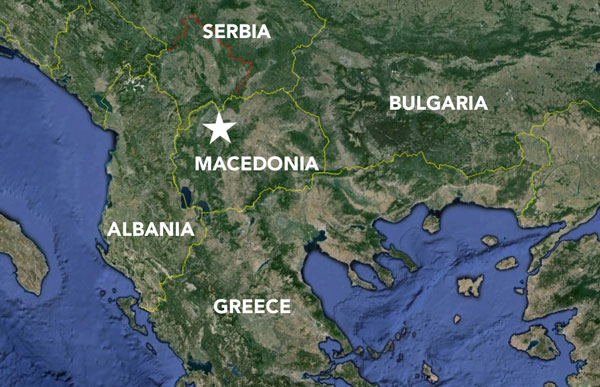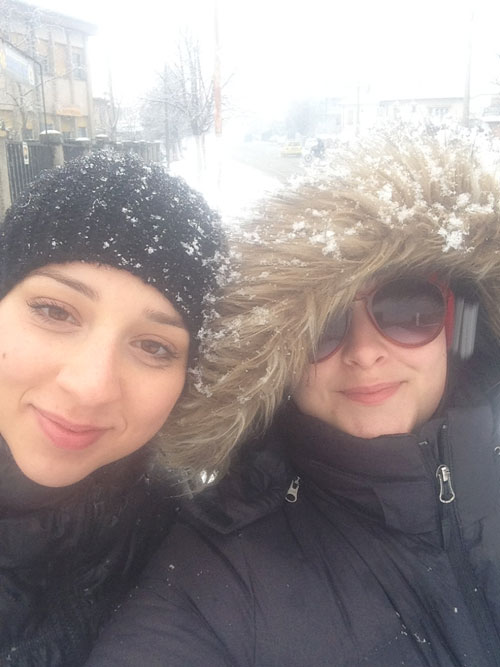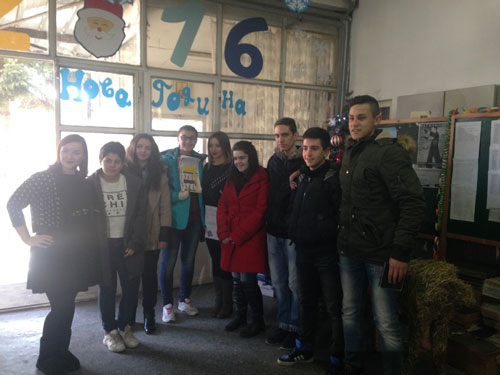Susan Schell remembers the first day she arrived in Prilep, Macedonia, in September 2014. As a student in the UAB Master of Arts in Education for Teaching English as a Second Language program, she had dreamed of working overseas. So she looked forward to volunteering at the vocational high school in the southeastern European nation.

“I was both scared and excited,” says Schell. “New people, new language, new life; it was all a little crazy, but also exhilarating.” The Birmingham native moved to Macedonia because of the Peace Corps Master's International (PCMI) program offered through the UAB School of Education’s ESL program. The School administers the program through a partnership with the Peace Corps to give graduate students the chance to combine school with a two-year stint as a Peace Corps volunteer.
While the Peace Corps assigned Schell to work in Macedonia, she says she originally wanted to teach in Nicaragua. She had, however, met a group of exchange students from Macedonia and Bosnia back in high school, so she welcomed the opportunity to visit the region. “Honestly, I love it here,” says Schell, “and I got very lucky in my program and my placement. I did have a bout of homesickness about six months in, but once I processed that, it was smooth sailing.”
A Call to Serve
The impetus for the Peace Corps began when President John F. Kennedy discussed an idea to send Americans to underdeveloped nations both to serve and promote cultural understanding. Afterward, by executive order, Kennedy established the Peace Corps in 1961. Today, the Peace Corps sends volunteers from the United States to other nations to help people come up with solutions to problems that impact the environment, health, education, economic development, or agriculture. Since its inception, more than 220,000 Americans have volunteered with the Peace Corps, according to the organization.
UAB Associate Professor Susan Spezzini, Ph.D., says she signed up for the Peace Corps in the 1970s after finishing graduate school at the University of California Berkeley. For two years, she taught health and nutrition classes to women living in parts of rural Paraguay. She then volunteered for a third year.
“There’s no comparison,” says Spezzini of her time in the Peace Corps. “If you haven’t had that experience, you don’t know what you’re missing. It just opens up the world to you.”
Spezzini spearheaded the effort to bring the PCMI program to the UAB School of Education in 2013. The UAB School of Public Health already had a partnership with the program dating back to 1987.

UAB students who are interested in PCMI can do so by first applying to the graduate degree program. The process includes interviews with the School of Education’s PCMI selection committee for admission to the graduate degree program. Next, a Washington D.C.-based Peace Corps committee interviews them. Finally, the Peace Corps assigns the students they select to various countries for service.
Spezzini says volunteers from the School of Education generally work in jobs related to their master’s degree. Just like all other Peace Corps volunteers, those selected for the PCMI undergo intensive language, culture and job training during the first three months in country.
For Schell, those first few months away from home were challenging, but also fun, she says.
“Probably my most memorable moment from the first week was going out with volunteers in Tetovo,” she says. “My group spent a week at a boarding school in Tetovo taking a crash course in Peace Corps information, basic language skills, and getting to know each other.
“I became fairly fluent in the language during that time, and also learned crucial information about what the culture was like and how schools here functioned,” Schell says. “My host family during the pre-service training was amazing and really made the three months delightful.”
While overseas, UAB students in the PCMI program must complete two graduate courses, Spezzini says. The first is a practicum course based on lesson plans, teaching units and reflections during their first year of teaching English as Peace Corps volunteers. The course culminates in a teaching portfolio. The students take their final UAB course during their second year in the Peace Corps. The field studies course is based on a community needs analysis and extends the students’ work beyond the school into the greater community.
Cross-Cultural Connections
As a part of the service component of the PCMI program, students are encouraged to identify a particular problem at their worksite. Then they must develop a plan of action to solve the issue using what they have learned in their ESL classes at UAB.
Schell says she has exchanged information and ideas about teaching styles with a Macedonian teacher who works in the classroom with her. She says the experience has given her not only more classroom teaching experience, but also a better understanding of what ESL students go through while trying to learn a new language.
“I’m in a challenging high school with students who don’t always have the background to learn English on the level that’s expected of them,” she says. “It has made me learn how to be very creative in the classroom.”

Meanwhile, in the South Pacific, 1,400 miles north of New Zealand, another PCMI student named Atkins Trout is teaching English in the Free Wesleyan Educational System in the nation of Tonga. But the UAB graduate student from New Albany, Miss., is also working with an academic support committee that is helping with tutoring, literacy and exam preparation for secondary students; a Saturday reading circle for children; and a Sight Words Book committee that aims to produce English language sight word books that have strong Tongan cultural themes, he says.
“I’m getting great practical experience with TESOL methods and applications while teaching here,” says Trout who wants to eventually enter the Foreign Service. “It’s teaching me to be resilient and to deal with stumbling blocks such as a lack of resources. It’s been just one more chance for me to view my own culture through the eyes of people who aren’t American. I think that kind of reflection will serve me well in my future, potential career paths.”
Brian Rice, a student in the UAB master’s degree program for teaching ESL, says he is looking forward to becoming a Peace Corps volunteer. Rice, a native of Anniston, says he plans to begin work with the Peace Corps in February of 2017 and is waiting on a country assignment.
“Peace Corps’ mission is to help build cross-cultural connections through service in sectors of need,” Rice says. “This core value of the Peace Corps is something I connect with on a personal level, and I feel that my skills as an educator could be best served in the sort of intimate and sustainable way the Peace Corps offers.”
A New Chapter
Last year, the UAB School of Education expanded its relationship with the Peace Corps by including other majors and teaching fields in its PCMI program and also by agreeing to host a Peace Corps Coverdell Fellows program. The Coverdell Fellows program is for returning Peace Corps volunteers who, after completing their two-year service overseas, want to pursue a graduate degree.
“We just started advertising it last semester,” Spezzini says. “I hope to see our first candidates begin this fall.”
Schell says that once her term with the Peace Corps ends in November 2016, she plans to apply for a job teaching in Vietnam or Thailand. Her time in the Peace Corps, she says, has had a profound impact on her life.
“I’ve grown in ways I didn’t know I was capable,” says Schell. “I’ve learned to be more outgoing. I’ve learned a different language. I’ve learned a different alphabet ... All of those things have caused me to grow as a person in leaps and bounds.”